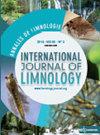新热带断续河流中木爪蝗种群结构和性成熟的季节变化
IF 0.9
4区 环境科学与生态学
Q4 LIMNOLOGY
Annales De Limnologie-international Journal of Limnology
Pub Date : 2022-01-01
DOI:10.1051/limn/2022007
引用次数: 1
摘要
Sylviocarcinus pictus是最近首次在Caatinga生物群系中记录的南美洲淡水蟹。本研究的目的是研究巴西半干旱东北地区的pictus种群和生殖生物学特征,并验证季节性环境变化对该种群的影响。这些螃蟹是在2013年10月至2014年9月期间每月从巴西PI的瓜里巴斯河一段水域收集的。对蟹类进行了鉴定、性别鉴定和甲壳宽度测定。生理性成熟是根据性腺发育阶段来确定的。共捕获螃蟹178只(雄111只,雌67只),雌雄比例为1.66:1。在干旱的几个月里,收集到的螃蟹数量更多。雄性和雌性分别以36.80和34.20 mm的CW达到生理性成熟。在整个研究过程中,性腺发育或正在发育的个体的出现表明,这些螃蟹在一年中不断繁殖,尽管在2月和5月招募较多。我们的研究结果表明,该种群在间歇性环境中使用一种生殖策略来优化其生殖适应性。本文章由计算机程序翻译,如有差异,请以英文原文为准。
Seasonal variation in population structure and sexual maturity of Sylviocarcinus pictus (Decapoda: Trichodactylidae) in a Neotropical intermittent river
Sylviocarcinus pictus is a South American freshwater crab recently recorded for the first time in the Caatinga biome. Our objective was to characterize the population and reproductive biology of S. pictus from the semi-arid northeastern region of Brazil and verify the influence of seasonal environmental changes in this population. The crabs were collected from a stretch of Guaribas River, PI, Brazil, every month between October 2013 and September 2014. The crabs were identified, sexed and the carapace width (CW) was measured. Physiological sexual maturity was determined based on the gonadal development stage. A total of 178 crabs were obtained (111 males and 67 females), with a sex ratio biased towards males 1.66:1. The number of crabs collected was higher in the months of drought. Males and females reach physiological sexual maturity with 36.80 and 34.20 mm of CW, respectively. The occurrence of individuals with developed or developing gonads throughout the study indicates that these crabs reproduce continuously during the year, although recruitment was higher in February and May. Our results indicate that this population uses a reproductive strategy to optimize its reproductive fitness in an intermittent environment.
求助全文
通过发布文献求助,成功后即可免费获取论文全文。
去求助
来源期刊
CiteScore
2.20
自引率
0.00%
发文量
0
审稿时长
>12 weeks
期刊介绍:
Annales de Limnologie - International Journal of Limnology publishes papers on the ecology of freshwater systems, ranging from studies of aquatic organisms, physical and chemical works which relate to the biological environment, to ecological applications and frameworks for water management directives.
Main topics: Ecology of freshwater systems ; biodiversity, taxonomy, distribution patterns in space and time, biology of animals and plants ; experimental and conceptual studies which integrate laboratory and/or field work on physiology, population dynamics, biogeochemistry and nutrient dynamics, management, mathematical modelling ; techniques for sampling and chemical analyses, ecological applications, procedures which provide frameworks for environmental legislation.

 求助内容:
求助内容: 应助结果提醒方式:
应助结果提醒方式:


